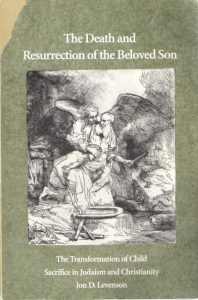 1. The offering of Isaac: its evolution into the template of the Jesus event: 1 (2008-05-18)
1. The offering of Isaac: its evolution into the template of the Jesus event: 1 (2008-05-18)
First post in a series discussing Jon D. Levenson’s The Death and Resurrection of the Beloved Son: The Transformation of Child Sacrifice in Judaism and Christianity.
Levenson’s argument is that the Jewish interpretations of the Aqedah (the story of the Binding of Isaac at his moment of sacrifice by Abraham) developed into an etiology of the Passover, and Isaac himself eventually became a willing sacrificial victim for the redemption of Israel. These interpretations can be traced from the second century b.c.e. Chistianity displaced this Isaac legend with its theology of the Jesus crucifixion.
In this first post we see how the intertestamental writings transformed the offering (sacrifice) of Isaac with the Passover.
–o–
2. The offering of Isaac: its evolution into the template of the Jesus event: 2 (2008-05-20)
If the Book of Jubilees is evidence that Jewish interpreters of the Genesis story of Abraham’s offering of Isaac implied an identification of Isaac with the Passover lamb, later rabbis made the identification unambiguously explicit. . . . . Levenson sees an interesting common matrix for both the Christian Eucharist (as typified today by the Catholic mass with its emphasis on intertwined prayer and sacrificial meal) and the Jewish Shemoneh Esreh. Both grew out of the practice of Jewish sacrifices and both owe a lot to post-biblical [“Old Testament”] Jewish exegesis.
–o–
3. The Offering of Isaac: its evolution into . . . Jesus event, 3 (2008-05-20)
Jewish interpreters were also transforming the story of Abraham offering his hapless son into a story of Isaac freely and with full awareness offering himself as a sacrifice for God. The message shifted from a child sacrifice to a son willingly offering himself as a sacrifice on behalf of all Israel.
–o–
4. The Offering of Isaac . . . . 4: death and resurrection (2008-05-23)
This post shows how a belief arose that Isaac was literally slain and had his blood shed but that he was resurrected again. His blood was said to have the atoning power of a martyr’s for God’s people.
–o–
5. Beloved and Only Begotten Sons Sacrificed by Loving Fathers (Offering of Isaac, 5) (2008-05-25)
A historical survey of the terms “beloved son” and “only begotten son” and how they merged to apply to the one to be sacrificed.
–o–
6. Jesus displaces Isaac: midrashic creation of the biblical Jesus . . . (Offering of Isaac . . . #6) (2008-06-06)
Levenson argues that much of the early Christology derives from a midrashic combination of verses associated with
-
- Isaac, the beloved son of Abraham,
- the Suffering Servant in Isaiah who went, like Isaac, willingly to his slaughter,
- another miraculous son, the son of David, the future messianic king laden with hopes of restoring the nation and establishing justice and peace throughout the world.
–o–
7. Jesus supplants Isaac — the contribution of Paul (2008-06-26)
The significance of Paul’s identification of Christ with both the Passover and with Isaac, and how Jesus displaced Isaac and the Church the Jews.
–o–
8. Remaking God in the Image of Abraham (2008-06-29)
How the character of God was transformed by early Christianity through its midrashic reading of the Jewish scripture stories of “the beloved son”.
–o–
9. The Isaac and Joseph Christologies; & rivalry for Scripture & Father (2008-07-09)
This post concludes the series outlining key aspects of Levenson’s argument that the Christian narrative of the atoning and saving death and resurrection of the Beloved (Only) Son was borrowed from late Second Temple Jewish midrashic interpretations of their scriptures about Isaac, Joseph and others. While the cosmic significance of this event is attributed to Jewish apocalyptic, the story itself is a natural evolution or mutation of a Jewish idea that had been on the burner for some time.
Levenson concludes by drawing the two Beloved Son narratives together, and then showing the Christian counterpart in a similar Jewish parable. Rather than seeing Christianity as a “child” born of the “parent” of Judaism, Levenson concludes that it is more accurate to see the two religions originating as sibling rivals, each competing for their father’s unique blessing.
–o–
–o–
# Midrash and Gospels 3: What some Jewish scholars say (and continuing ‘Midrash Tales of the Messiah’) (2011-08-05)
This post on Levenson’s The Death and Resurrection of the Beloved Son is part of another series discussing the meaning of midrash.
–o–